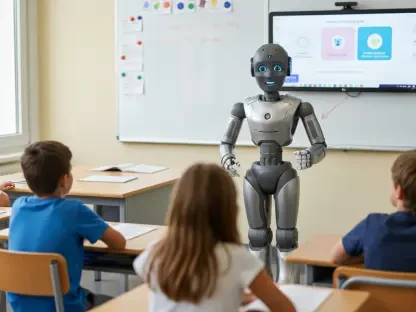Understanding the Current State of AI and Its Limitations
The artificial intelligence (AI) industry stands at a pivotal moment in 2025, with remarkable advancements in large language models and image classifiers driving progress across sectors like healthcare, finance, and entertainment. However, despite these achievements, a significant gap persists in AI’s ability to interact meaningfully with the physical world. Current systems excel at processing text and static visuals but often falter when required to navigate dynamic, unpredictable environments, revealing a critical limitation in their design and application.
Key players such as Google DeepMind and Nvidia are pushing boundaries with innovative tools, yet the industry recognizes that true autonomy remains elusive without a deeper understanding of spatial dynamics. Physical-world interaction is becoming increasingly vital as AI applications expand into areas like autonomous vehicles and industrial robotics. The inability to perceive depth, movement, or object interactions restricts these systems to controlled settings, hampering their potential for broader, real-world deployment.
This gap in spatial understanding poses a barrier to adoption in sectors where adaptability is paramount. For instance, while AI can analyze vast datasets, it struggles to predict consequences in real-time scenarios, such as a robot adjusting to a sudden obstacle on a factory floor. Addressing this shortfall is not just a technical challenge but a necessity for unlocking the full spectrum of AI’s transformative capabilities across diverse industries.
The Rise of Spatial Intelligence as a Game-Changer
Key Trends Driving the Need for Spatial Awareness
A notable shift in AI development is underway, moving from passive data processing to active, context-aware engagement with the physical environment. This evolution is driven by the growing demand for systems that can interpret and respond to real-world conditions in real time. Technologies such as spatial computing, computer vision, and real-time mapping are at the forefront, enabling machines to better understand their surroundings and make informed decisions.
Industries are increasingly prioritizing adaptability in dynamic settings, whether it’s autonomous vehicles navigating busy streets or warehouse robots managing shifting inventory. This trend reflects a broader need for AI to go beyond static analysis and engage with the complexities of movement and spatial relationships. Consumer expectations are also evolving, with a preference for intuitive systems that can anticipate needs based on physical context, such as smart home devices adjusting to user behavior.
Moreover, industrial applications highlight the urgency for AI to predict outcomes and respond to changes effectively. The ability to foresee consequences—such as a drone avoiding a collision mid-flight—marks a significant leap from reactive to proactive intelligence. These emerging demands underscore why spatial awareness is becoming a cornerstone of AI innovation, setting the stage for more seamless human-machine interactions.
Growth Potential and Industry Impact
The trajectory of spatial intelligence technologies points to substantial growth, with projections indicating a transformative impact across multiple sectors. According to recent insights from the World Economic Forum, spatial computing is expected to redefine operational models by integrating digital and physical realms, with market expansion anticipated through 2027. This growth is fueled by the promise of enhanced safety and efficiency in applications ranging from autonomous driving to industrial automation.
Performance metrics already demonstrate tangible benefits, such as reduced accidents in self-driving cars equipped with advanced spatial recognition and improved productivity in factories using context-aware robots. These indicators suggest that investing in spatial intelligence can yield significant returns, not just in operational gains but also in fostering trust in AI systems. The potential to minimize errors in high-stakes environments is a compelling driver for adoption.
Looking ahead, spatial intelligence is poised to reshape markets by creating opportunities in areas like urban planning, where AI could optimize traffic flow, and logistics, where real-time mapping could streamline supply chains. The ripple effects extend to human-machine collaboration, enabling more intuitive interfaces that adapt to user movements. As these technologies mature, they are likely to unlock entirely new paradigms of interaction and efficiency.
Challenges in Developing Spatial Intelligence for AI
Developing AI with robust spatial intelligence presents formidable technical hurdles, particularly in achieving real-time perception of geometry, depth, and object interactions. Unlike static data processing, this requires systems to continuously interpret and adapt to changing environments, a task that demands immense computational power and sophisticated algorithms. The complexity of mimicking human-like spatial reasoning remains a significant obstacle for researchers and engineers.
Beyond technical barriers, market-driven challenges add to the difficulty, with high research and development costs posing a major constraint. Building world models—internal simulations of physical reality—necessitates vast, diverse datasets that are often expensive to curate. Additionally, the lack of standardized frameworks for training AI in dynamic scenarios slows progress, as companies must navigate uncharted territory to create reliable systems.
Potential solutions are emerging, such as leveraging simulated environments like digital twins to replicate real-world conditions for training purposes. Partnerships between industry leaders also offer a way forward, allowing shared resources and expertise to accelerate innovation. By pooling data and computational capabilities, stakeholders can address cost barriers and drive collective advancements in spatial intelligence, paving the way for scalable applications.
Navigating the Regulatory and Ethical Landscape
The deployment of spatial intelligence in AI intersects with a complex regulatory environment, where data privacy and safety standards take center stage. As systems interact more directly with the physical world—whether through autonomous vehicles or factory robots—ensuring compliance with stringent guidelines becomes critical. Governments worldwide are tightening oversight to protect individuals and infrastructure from potential risks associated with AI errors or misuse.
Compliance is especially vital in high-risk applications, where a single miscalculation could have severe consequences. For instance, autonomous systems must adhere to safety protocols to prevent accidents, while data collection for spatial mapping raises concerns about user consent and surveillance. Striking a balance between innovation and accountability is essential to maintain public trust and enable widespread adoption of these technologies.
Evolving regulations may shape the pace of development, with stricter policies potentially slowing experimentation but also ensuring responsible practices. Ethical frameworks are equally important, guiding how spatial intelligence is applied to avoid bias or harm. Stakeholders must prioritize transparency and fairness, addressing societal implications to foster an environment where innovation aligns with public good and safety.
The Future Horizon of Spatial Intelligence in AI
Emerging technologies are set to propel spatial intelligence to new heights, with advanced world models and sensor integration leading the charge. These tools aim to create AI systems that not only perceive their surroundings but also anticipate outcomes with precision, mirroring human intuition. Developments in real-time data processing and 3D modeling are enhancing the ability of machines to navigate complex, ever-changing spaces.
Potential disruptors, such as breakthroughs in simulation platforms, could accelerate this progress by offering low-risk environments to test and refine AI capabilities. The convergence of digital and physical realms is another game-changer, blurring boundaries through persistent layers of intelligence that interpret context on the fly. Such advancements promise to redefine how industries operate, from smarter urban systems to more responsive personal devices.
Growth areas are vast, with consumer preferences leaning toward intuitive AI interfaces that understand spatial cues, like gesture-based controls. Global economic and technological trends, including increased investment in automation, are likely to boost adoption rates over the coming years. As these forces align, spatial intelligence stands to become a foundational element of AI, driving innovation in ways that are both practical and visionary.
Conclusion: Embracing Spatial Intelligence for Transformative Innovation
Reflecting on the journey of AI development, it becomes clear that spatial intelligence holds the key to overcoming longstanding limitations, bridging the gap between digital analysis and physical interaction. Its integration marks a turning point, enabling machines to move beyond passive roles into active participation across industries. The discussions around growth potential and real-world impact underscore a shared recognition of its transformative power.
Looking back, the challenges of technical complexity and regulatory navigation stood as significant hurdles, yet they also spurred collaborative solutions and ethical considerations that shaped a more responsible path forward. The strides made in world models and spatial computing laid a robust foundation for safer, more efficient systems, from autonomous transport to industrial automation.
As a next step, stakeholders are encouraged to deepen investments in simulation technologies and foster cross-industry partnerships to scale innovations. Prioritizing ethical frameworks alongside technological advancement ensures that spatial intelligence evolves in alignment with societal needs. This strategic focus promises to unlock unprecedented opportunities, redefining human-machine collaboration for generations to come.









